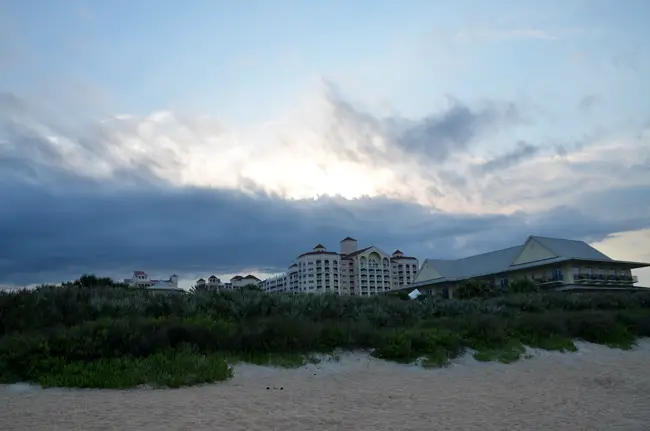
It’s come to this. Sometime this morning—the item is last on a long agenda—Flagler County Commissioner Milissa Holland and other local representatives will square off against Hammock Dunes developers before Gov. Rick Scott and the rest of the Florida Cabinet. Flagler County wants to stop Ginn-LA from building a 77-foot hotel tower over what had been pledged as a “perpetual” golf course, a structure that would cast shadows over previous promises, not to mention a public beach, and potentially alter that beach’s public access at 16th Road in the Hammock.
Click On:
- Timeline: Hammock Dunes DRI, 1982-2011
- Trial May Settle Ginn-County Dispute Over Towering Condo at Hammock Dunes
- In Knotty Deal, County Agrees to 980-Acre Buy from Ginn Co. for at Least $3.25 Million
- Burned Just 4 Months Ago, County Cooks Yet Another Risky Deal With Ginn on Public Dime
- How Ginn Corp. Stuck Flagler Taxpayers With a $2 Million White Elephant
The Documents:
- Draft Final Order
- County Exhibit: Conditions and Potential Development Scenarios
- Judge D.R. Alexander’s Ruling
- Developer’s Exceptions to Alexander Ruling
- Ginn-Lubert-Adler’s Proposal
- The County’s Response
- The Owners Associations’ Position
- Cushman & Wakefield Hammock Dunes Flyer
It all started two and a half years ago as a request by Ginn-Lubert Adler to change course at the massive Hammock Dunes development. The developer and its investors filed a so-called “notice of potential change” (NOPC) in the residential density and layout of a particular area of the development—the area that includes the Atlantic Grill, a 20-room hotel and lodge and the Hammock Dunes Golf Course, all on either side of 16th Road, at the eastern edge of which is the public park and public beach access.
Most of that would change if Ginn-LA’s designs were to go through. For the past two and a half years, the developer—in what Holland once described as living through “Groundhog Day”—tried repeatedly to win approval for upping the residential density of that area by 561 condo-hotel units while lowering the overall density of Hammock Dunes, which slumps over five miles of Atlantic beachfront and includes Hammock Dunes, Ocean Hammock and Hammock Beach. (Ginn-LA Marina, Northshore Hammock and Northshore Ocean Hammock Investment are the parties pressing for the change.)
Residents of the development aren’t happy. They say they bought into the properties there for the views—and property values, which Flagler County Property Appraiser Jay Gardner said in one court proceeding would fall by more than 40 percent if the new structure were to rise. The Ocean Hammock Property Association, the Hammock Beach Club Condominium Association and Admiral Corporation—the original developer of Hammock Dunes in the 1980s—have all joined Flagler County in opposition to the development’s new wrinkle.
County commissioners say the character of the area would be radically altered by the massing up of density, and the natural experience of beachgoers would be damaged. But they’re facing an unlikely trump card in Ginn-LA’s arsenal: county government’s own staff’s recommendation that the commission approve the change.
County staff and Ginn have had a cozy relationship for years: the county built a $2 million hangar for the original Bobby Ginn’s company (Bobby Ginn is no longer directly involved in the Hammock Dunes development), only to be left holding the bag when Ginn’s development company went bankrupt and walked out on some $200,000 a year in mortgage payments. Last year, also on the staff’s recommendation, the commission went along with a $3.25 million deal, allowing Ginn to unload undevelopable land at taxpayers’ expense in exchange for the land’s dubious potential as a “wetland credit bank.” The deal nearly wiped out Flagler’s own bank, fed by taxpayer dollars, set aside for environmentally sensitive lands.
All along, Ginn-LA was working through county staff to win approval for its Hammock Dunes alterations, which it did, but never with commissioners’ approval. Ginn-LA altered its proposal several times, lowering densities and pledging to build fewer than 300 units. The commission wouldn’t go along. The two sides went to trial before an administrative law judge in December.
The judge ruled in favor of the county commission, and forwarded a proposed final order to the governor and the cabinet denying Ginn-LA’s request. Ginn-LA filed 15 exceptions to the decision, which were systematically rejected—or denied—one by one, including a central claim by Ginn-LA that it had a “right” to develop the area in question. It doesn’t, the county and the judge agreed. The judge also agreed with the county’s interpretation that “the golf course land will remain a golf course in perpetuity and cannot be developed for residential purposes.”
Now it’s up to the Florida Cabinet. That’s the case the Cabinet will decide today. It may not be over even then: the decision may be appealed to the First District Court of Appeal.





























Leave a Reply